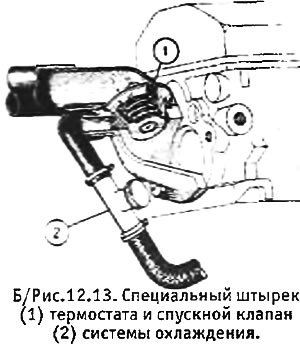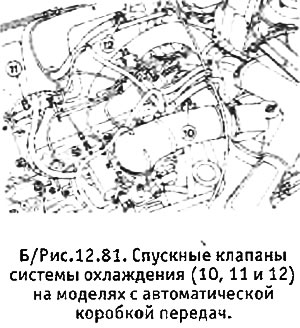2. Slowly pour coolant into the system until the level reaches the radiator filler neck. Gently squeeze the upper and lower radiator hoses by hand in order to remove air pockets, and then continue to fill the liquid until its level is not lower than 50 mm from the bottom of the filler neck.
3. Replace and securely tighten the radiator cap. Start the engine and let it idle until the coolant has warmed up. After that, step on the gas several times so that the idle speed rises to fast, which will allow you to remove the remaining air plugs from the system. Turn off the engine.
4. Carefully remove the radiator cap and add coolant to the previous level (see paragraph 2). Reinstall the plug.
5. If you have not changed the coolant, remember that by adding water to it, you dilute the antifreeze and weaken its properties. Therefore, it is better to use a ready-made mixture of antifreeze with water for topping up.
6. Start the engine again and inspect the cooling system for leaks.
Filling coolant (models before 1983)
1. If you are having trouble with air locks when filling the cooling system, you can purchase a connector with a bleed valve that fits onto the small hose that runs from the thermostat housing to the heater return hose. At the same time, check that the thermostat has a special pin and that the thermostat can move freely in its socket (see b/fig. 12.13).

2. When filling the system, open the drain valve (if applicable) and pour liquid until its level is about 5 cm below the filler neck (an alternative method of bleeding the system is to temporarily loosen the hose clamp on the thermostat housing). When coolant that does not contain air bubbles begins to flow from the bleed valve or loose hose clamp, close the valve or tighten the clamp.
3. Replace the radiator cap, start the engine and warm it up to normal operating temperature. Switch off the engine, let it cool down and top up the system with coolant if necessary.
Filling coolant (XU engines)
1. Set heater control to HOT (maximum heating), open 2 drain valves (see pictures) and remove the plugs from the radiator and expansion tank. Close the drain cock and replace the drain plug. (On models with an automatic transmission and on all models from 1986, there are three bleed valves - see B/fig. 12.81).

2. Pour coolant into the radiator until it is full and replace the radiator cap. Go to the expansion tank and fill it with fluid until the correct level is reached. Close the bleed valves when liquid begins to flow out of them, not containing air bubbles.
3. Replace the expansion tank cap, start the engine and warm it up to normal operating temperature (before cooling fan). Let the engine run for another 5 minutes, then turn it off and let it cool down for at least 2 hours.
4. Check the fluid level in the expansion tank and top up if necessary.
